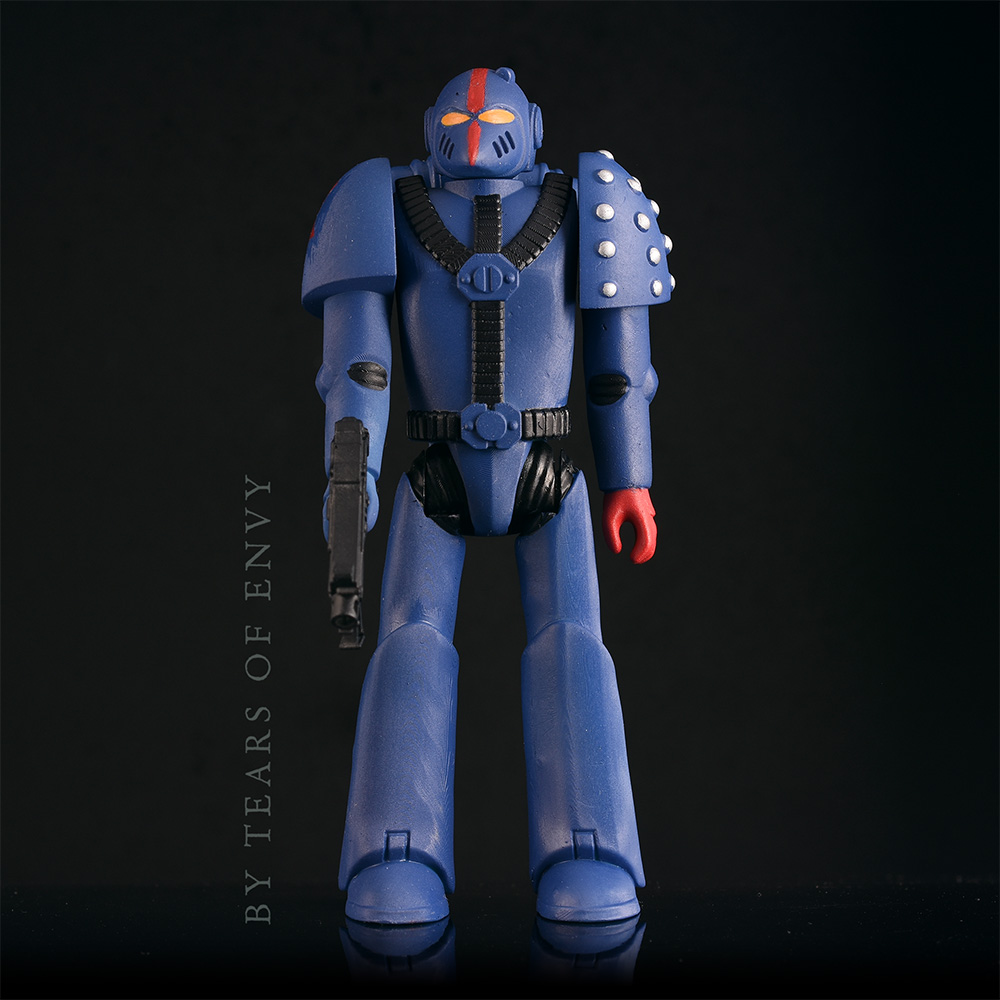These figures are inspired by speculation of what a late 1980s Space Marine action figure might have looked like.
Space Marines are the stars of the Warhammer 40,000 tabletop wargame. Upon its release in 1987 the game was then known as ‘Rogue Trader’ because the full title of the game’s first edition was the somewhat clunky Warhammer 40,000; Rogue Trader. Space Marines are human super soldiers in power armour and acted as the ‘poster boys’ for the game and the franchise it went on to spawn.
The 1980s was the era where the 3 3/4″ format figures thrived, having emerged in the late 1970s. I seem to remember reading that the move down to this scale from the larger action figures of the ’60s and ’70s was partly due to the rising cost of plastics thanks to the oil shortage in the late ’70s, but don’t quote me on that. No Warhammer action figures were ever made at the time, and it was only very recently when Warhammer partnered with the likes of Bandai and McFarlane when modern action figures emerged (an endeavour I was heavily involved in as I was working in the Warhammer Licensing team at the time).
My ‘retro fiction-verse’ figures join a growing trend, popularised by companies like Super7, of making figures that ‘could have been’ – they are part of a wider vogue for retro-clone and de-make pop culture which harnesses either real or imagined nostalgia. I find this movement endlessly fascinating.
I am making these figures in ‘series’, each consisting of about four designs per wave. Each wave is inspired by the roughly chronological product history of Rogue Trader. At the moment the figures are largely identical designs, but I hope to add accessories as I go. The first of these unique parts is the smaller pistol the black figure carries.
The figures were sculpted in ZBrush with some parts done in Blender. I then 3D print them and made the backing cards in Photoshop using art and logos from the era. The ‘Nergal Snega’ brand is entirely fictional, too. I wrote some trash lore for this fake company, which you can find at the foot of this post. I probably got a bit carried away writing this, if I’m honest. The photo of the little boy is AI generated.
Note: These figures are completely unofficial and in no way endorsed by Games Workshop PLC. No claims are being made to Games Workshop’s intellectual property. The figures are a personal fan project and are not for sale.







Nergal Snega
Nergal Snega (often just referred to as ‘Snega’) was a British toy, game and electronics manufacturer that operated from 1982 to 2000. The company’s name was an anagram of its founder’s surname, Langrages. Bernard Langranges (b.1940) had achieved financial success in the field of agricultural machinery and formed the company in 1982, allegedly as a result of his son declaring that, “Star Wars figures are all bobbins now.” Langranges based the operation in Netherthong, Yorkshire, and the company’s first products were simple one-piece toy soldiers armed with machetes and carrying severed heads of their enemies. These sold well and the designers moved on to developing jointed action figures in the popular 3 ¾ inch scale.
Snega began work on the prototype of a video games console, partly after Langranges saw the success of the Nintendo Entertainment System in the USA during a trip related to his hobby of orangutan breeding. Due to financial setbacks Snega’s game console never reached production. At least one prototype model is known to exist and several games were put into production including ‘Muffin Factory’ about an enormously fat boy, coded by James Filiman (best known for the beat-em-up ‘Hurt Bastard’ on the Amiga 500). Regardless of the various setbacks in 1988 Snega updated their logo to reflect the growing success of video games after the launch of the Sega Genesis in Japan.
Snega is most famous for the small but successful lines of 3 ¾” action figures it produced. They typically featured five points of articulation, much like a real human. They included the controversial Alpaca Frenzy line of anthropomorphic terrorists, which was banned in South America due to some characters’ passing resemblances to Contra agents who operated out of Nicaragua. Other lines were: The Court of Miracles (featuring beggars from 13th century Paris), Paleozoic Field Studies (a collection of intelligent arthropods) and a licensed line of action figures based on the Warhammer 40,000 Rogue Trader tabletop game.
The company’s profits waned in the 1990s not least of which because of various court cases that had dogged Langranges for a decade. These related to animal smuggling and his insistence on always being naked, apart from a full pharaonic headdress, when visiting the Snega manufacturing facilities.


